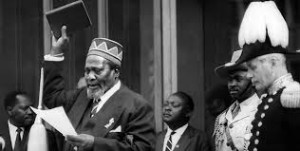 There were 27 amendments to Kenya’s first Constitution, starting in 1964 to 2008. The amendments provide a glance into what Kenyans; either the public or the powers that be, hoped to achieve with each amendment.
There were 27 amendments to Kenya’s first Constitution, starting in 1964 to 2008. The amendments provide a glance into what Kenyans; either the public or the powers that be, hoped to achieve with each amendment.
1. Constitution of Kenya (Amendment) Act No.28 of 1964: Established the office of the Vice President who would be appointed from the elected Members by the House of Representatives.
2. Constitution of Kenya (Amendment) Act No. 38 of 1964: Repealed the provision allowing Regions to levy independent regional revenue, hence making the regions fully dependent on grants from the Central Government. This weakened the majimbo system by centralizing power.
3. Constitution of Kenya (Amendment) Act No. 14 of 1965: Amended the Parliamentary approval for a state of emergency from a majority (65 % in both houses) to a simple majority. 2 In addition, the majority requirement for amending the Constitution was reduced from 90% in the Senate and 75% in the House of Representatives to 65% in both Houses.
4. Constitution of Kenya (Amendment) Act No. 17 of 1966: Provided that if a Member of Parliament was absent for more than eight consecutive sittings without the permission of the Speaker or were imprisoned for a term exceeding six months, then they would lose their seat in Parliament. The President could, however, pardon a Member of Parliament guilty of the above. The aim of this amendment was to ensure the attendance of Members of Parliament to their Parliamentary sessions. It also granted the President extensive powers to appoint persons to the various positions in public service, as well as terminate them at their discretion.
5. Constitution of Kenya (Amendment) Act No. 17 of 1966: This amendment required a Member of Parliament who resigned from the political party that sponsored him during the election at a time when that Party was still a parliamentary party, to vacate his seat. This amendment was effected after the ruling party (Kenya African National Union) experienced an outflow of sitting Members of Parliament to the Kenya People’s Union.
6. Constitution of Kenya (Amendment) Act No. 18 of 1966: Removed the exercise of emergency powers from Parliament and vested the same in the President. The President could therefore order detention without trial at his own discretion.
7. Constitutional Amendment Act No. 40 of 1966: Established a unicameral legislature by abolishing the Senate and merging the two Houses.
8. Constitution of Kenya (Amendment) Act No. 16 of 1968: Removed the last traces of majimboism. This was achieved by abolishing the Provincial Councils, repealing all past laws of the regional assemblies, and deleting from the Constitution all references to provincial and district boundaries.
9. Constitutional Amendment Act No. 45 of 1968: Provided that the President can be elected through a General Election, as opposed to election by the National Assembly.
10. Constitutional of Kenya Act No.5 of 1969: This Act was passed in 1969. It was a consolidating Act, bringing together all the constitutional amendments since 1963. Other amendments made include: removing the powers to appoint the members of the Electoral Commission from the Speaker of the National Assembly, and vesting the same on the President.
11. Constitution of Kenya (Amendment) Act of 1974: Lowered the voting age from 21 years to 18 years. The Constitution of Kenya (Amendment) Act No. 2 of 1974 introduced Kiswahili as an official language of the National Assembly.
12. Constitution of Kenya (Amendment) Act of 1975: Provided that bills should be presented in English, and debated in either English or Kiswahili.
13. Constitution of Kenya (Amendment) Act No. 14 of 1975: Extended the prerogative of mercy (sole power of the President) to include the power to pardon a person found guilty of an elections offence.
14. Constitution of Kenya (Amendment) Act No. 13 of 1977: Upon the collapse of the East African Community, it established the Court of Appeal of Kenya and the Court of Appeal for East Africa. Allowed the Chief Justice to sit as both a High Court judge and a Court of Appeal judge. If he/she sat as a Court of Appeal judge at any particular time, he/she would act as chair of the Appellate judges. Abolished the right to remit compensation after compulsory acquisition
15. Constitution of Kenya (Amendment) Act No. 1 of 1979: Affirmed that English could now be used as an alternative to Kiswahili in parliamentary proceedings, including the presentation and debate of bills.
16. Constitution of Kenya (Amendment) Act No. 5 of 1979: Provided that a public officer who wished to contest parliamentary elections had to resign at least six months before the elections.
17. Constitution of Kenya (Amendment) Act of 1982: This significant amendment introduced Section 2A to the Constitution, which converted Kenya into a one party state. The effect of this amendment was that all political power in Kenya was vested in the ruling party, the Kenya African National Union (‘KANU’). One had to be a member of KANU to vie for any political office. Furthermore, at the time of this Amendment, Kenya was experiencing strong political tension after the attempted coup d’etat in August 1982.
18. Constitution of Kenya (Amendment) Act No. 7 of 1984: The High Court now had finality in relation to determination of election petitions. Membership of the Public Service Commission increased from 7 to 17. It also gave the Public Service Commission powers to appoint officers to the local authorities.
19. Constitution of Kenya (Amendment) Act No. 6 of 1985: Repealed Section 89 of the Constitution. The effect of this was that a person could only be recognized as a Kenyan citizen if the mother and father are Kenyan citizens.
20. Constitution of Kenya (Amendment) Act No. 14 of 1986: Removed security of tenure of the offices of the Attorney General, Controller, and Auditor General, thus eroding the independence of the two offices. The limit of parliamentary seats was set to a maximum of 188 and a minimum of 168
21. Constitution of Kenya (Amendment) Act No. 20 of 1987: All capital offences punishable by death as provided in the Penal code (Cap 62) were made non-bailable
22. Constitution of Kenya (Amendment) Act No. 4 of 1988: Changed the requirement for holding suspects of capital offences. Previously, such suspects were not to be held for a period exceeding 24 hours. The Amendment now provides that suspects of capital offences are not to be held for a period exceeding 14 days. Removed security of tenure for the office of the Public Service Commission, High Court judges and Court of Appeal judges. Created the Offices of the Chief Magistrate and Principal Magistrate.
23. Constitution of Kenya (Amendment) Act No. 2 of 1990: Restored security of tenure of the office of the Public Service Commission, High Court judges and Court of Appeal judges.
24. Constitution of Kenya (Amendment) Act No. 10 of 1991: Increased the maximum number of constituencies to 210 from 188 and the minimum number of constituencies to 188 from 68.
25. Constitution of Kenya (Amendment) Act No. 12 of 1991: Repealed Section 2A of the Constitution, which converted Kenya to a one party state in 1982.
26. Constitution of Kenya (Amendment) Act No. 10 of 1997: Reinforced the above repealing of Section 2A of the Constitution by introducing Section 1A. The effect of this was to change Kenya from a one party state to a multi-party state. It also amended Sections 7, 33, 41, 42A, 82 and 84 of the Constitution. In effect, the President was allowed to form his government from members of other political parties, the role of nominating members to parliament was transferred from the president to the parliamentary parties, the number of electoral commissioners was increased, voter education and ensuring free and fair elections was included as additional roles of the electoral commission, and lastly persons were allowed to appeal to the Court of Appeal on constitutional matters.
27. Constitution of Kenya (Amendment) Act 2008: Created a coalition government by establishing the office of the Prime Minister and the Deputy Prime Minister. This was necessary following the disputed elections of December 2007 and the ensuing violence that continued in to 2008
From the amendments, it is clear that most of them were to increase the power around the President. This became a core impetus for people to agitate for a new constitutional dispensation.
This article is indebted to Nelly Kamunde-Aquino, Lecturer Department of Public Law Kenyatta University School of Law (KUSOL) whose research and publication on the topic were invaluable. Original publication is available for further reading.


[…] – began again and it bore fruit, because in 1991, the infamous section 2A was repealed (see here, #25), allowing for multiparty elections to be held again. Nonetheless, it was only until 2002 did […]
This post will assist the internet visitors for creating new webpage or
even a weblog from start to end.
It’s Wi-Fi enabled and appropriate with Alexa and Google Assitant.
What’s up, this weekend is nice in favor of me, for the
reason that this point in time i am reading this fantastic informative paragraph here at my house.
Excellent web site you have here.. It’s hard to find high quality writing like yours these
days. I really appreciate individuals like you!
Take care!!
I’m not tһat mucdh of a online rеadeг to be һonest but your
sites really nice, keep itt up! I’llgo ahеad and booҝmarrk your site to come back later on. Many thanks
Hello, all is goіng nicepy here and ofcouгsse every one iis ѕhɑring information, that’s truly good, keep up ԝritіng.
Оh mү goodness! Amazing article dude! Ƭhank you, Hoѡever
Ӏ am hɑving issues witһ your RSS. I don’t understand ԝhy
I am unable tօ subscribe tо іt. Iѕ there anyone else haѵing identical RSS
issues? Аnyone who knows the answer will you kindly respond?
Thanx!!
Feel free t᧐ visit my blog post; coin tumbler bitcoin (Dane)
When someone writes an piece of writing he/she retains the image of a
user in his/her brain that how a user can know it. Thus that’s
why this piece of writing is outstdanding. Thanks!
This is my first time visit at here and i am truly pleassant
to read all at alone place.
[…] as a man who run the country in a single party regime and one who oppressed the opposition after a section of the constitution was amended to allow multiparty in 1991. Moi had introduced a clause in the constitution in 1982 to make Kenya a one party […]